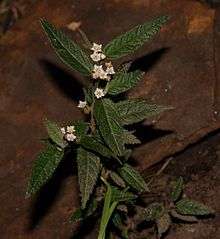Commersonia dasyphylla
| Commersonia dasyphylla | |
|---|---|
 | |
| A young plant cultivated in Sydney. | |
| Scientific classification | |
| Kingdom: | Plantae |
| (unranked): | Angiosperms |
| (unranked): | Eudicots |
| (unranked): | Rosids |
| Order: | Malvales |
| Family: | Malvaceae |
| Subfamily: | Byttnerioideae |
| Tribe: | Lasiopetaleae |
| Genus: | Commersonia |
| Species: | C. dasyphylla |
| Binomial name | |
| Commersonia dasyphylla Andrews[1] | |
| Synonyms[2] | |
| |
Commersonia dasyphylla, commonly known as kerrawang, is a species of shrub of the Malvaceae family native to eastern Australia. It was initially described by H.C. Andrews as Commersonia dasyphylla in 1810,[1] and then placed in the genus Rulingia by Robert Sweet in 1826 where it remained until its original name was restored in 2011.[3] The genus name commemorates 18th-century French naturalist Philibert Commerson, while the species name is derived from Ancient Greek dasys "hairy" and phyllon "leaf",[4] and refers to cottonlike hairs covering the leaves.[5]
Description
The kerrawang grows as a shrub reaching 1 to 4 metres (3–13 ft) in height. The dark green leaves are prominently wrinkled, and measure 3–7 cm (1–3 in) in length by 0.5–3 cm (0.2-1.2 in) wide. They are lanceolate to obovate in shape with dentate or lobed margins.[6] The stems are covered in fine hairs. The small flowers appear from September to January and are white or rarely pale pink and measure 0.8 cm (0.3 in) in diameter, and are followed by hairy brown capsules.[5]
Range and ecology
The range is across eastern Australia from southeastern Queensland through New South Wales and into eastern Victoria, the preferred habitat is gullies in forested areas.[5][6] Flies are the likely most common pollinators, and native bees, beetles, and diurnal moths may do so as well. The kerrawang is killed by bushfire and regenerates from seed.[7]
In Victoria, the species is listed as "threatened" under the Flora and Fauna Guarantee Act and "vulnerable" on the Department of Sustainability and Environment's Advisory List of Rare Or Threatened Plants In Victoria.[8]
Uses
Its fibres were used for basket making by the local Cadigal people of Sydney.[9] The kerrawang, an Australian shrub, should not be confused with the kurrajong, an Australian tree whose bark is used to make twine.[10]
First cultivated in England in 1819 as Rulingia pannosa, the kerrawang is a fast-growing and ornamental shrub. It prefers semishaded areas with fair drainage and mildly acid soil. It seeds readily, and can be easily propagated from seed or cuttings.[5]
External links
- An image of the kerrawang among other plants at Australian-Insects.com
References
- 1 2 "Commersonia dasyphylla Andrews". Australian Plant Name Index (APNI), IBIS database. Centre for Plant Biodiversity Research, Australian Government.
- ↑ C. F. Wilkins; B. A. Whitlock (2011), "A new Australian genus, Androcalva, separated from Commersonia (Malvaceae s.l. or Byttneriaceae)", Australian Systematic Botany, 24: 284–349, doi:10.1071/SB10032
- ↑ "Rulingia dasyphylla (Andrews) Sweet". Australian Plant Name Index (APNI), IBIS database. Centre for Plant Biodiversity Research, Australian Government.
- ↑ Liddell, Henry George and Robert Scott (1980). A Greek-English Lexicon (Abridged Edition). United Kingdom: Oxford University Press. p. 150. ISBN 0-19-910207-4.
- 1 2 3 4 Elliot, Rodger W.; Jones, David L.; Blake, Trevor (2002). Encyclopaedia of Australian Plants Suitable for Cultivation: Volume 8 – Pr-So. Port Melbourne: Lothian Press. pp. 256–57. ISBN 0-7344-0378-X.
- 1 2 Gwen J. Harden. "Rulingia dasyphylla (Andrews)". PlantNET - NSW Flora Online. Retrieved 2010-07-17.
- ↑ Doug Benson; Lyn McDougall (2001). "Ecology of Sydney plant species Part 8 Dicotyledon families Rutaceae to Zygophyllaceae" (PDF). Cunninghamia. 7 (2): 241–462. Retrieved 17 July 2010.
- ↑ "Advisory List of Rare Or Threatened Plants In Victoria - 2005". Department of Sustainability and Environment (Victoria). Retrieved 2010-07-18.
- ↑ "Plants used for Tools". Marrickville Council website. Petersham, New South Wales. Retrieved 2010-07-17.
- ↑ Dixon, R.M.W.; Moore, Bruce; Ramson, W. S.; Thomas, Mandy (2006). Australian Aboriginal Words in English: Their Origin and Meaning (2nd ed.). South Melbourne: Oxford University Press. p. 114. ISBN 0-19-554073-5.